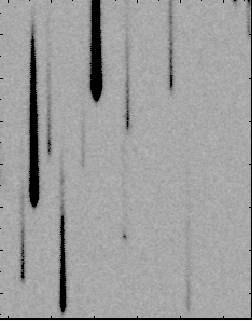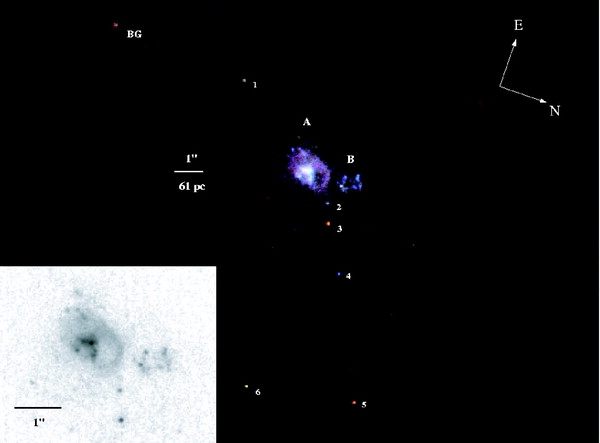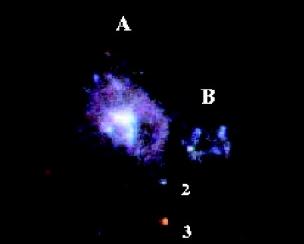Hamburger Sternwarte - Research
Hamburg / SAO Survey for Emission Line Galaxies (HSS)
The Hamburg / SAO Survey for Emission Line Galaxies (HSS) uses the objective prism plates of the Hamburg Quasar Survey to discover compact dwarf galaxies undergoing a strong starburst event and other galaxies with strong emission lines. The survey is used to find galaxies with low metallicity content and to study the large scale distribution of low mass galaxies.
The cooperation on HSS was initiated by the late V.A. Lipovetsky (SAO) during a visit in Hamburg in 1993. In 1997 the cooperation was extended including now other groups from France, Germany, Israel, Spain and the Ukraine as well. Funding by INTAS was obtained 1997-2000.

| |
Figure 1: Sky coverage of the Second Byurakan Survey (green), the HSS (blue) and the Case Survey (pink). All known emission line galaxies are plotted. (From SAO HSS homepage)
|
The HSS covers a region of ~1700 deg 2 bridging the gap between two other surveys: The Second Byurakan Survey and the Case Low Dispersion Survey (Figure 1). Follow-up spectroscopy is obtained with the SAO 6m telescope,
with the Calar Alto 2.2m telescope,
the KPNO 2.1m and 4m-telescopes. 547 galaxies were discovered
so far (see Source Catalogue).
The most spectacular discovery is the nearby extreme metal-poor dwarf galaxy HS 0822+3542. Its metallicity is only 1/36 of the solar value. Only two other galaxies with lower metallicities are known. Figure 2 shows the appearance of HS 0822+3542 on the objective prism plate, while Figure 3 shows its rich emission line spectrum.
 |
 |
|
Figure 2: Discovery objective prism spectrum of HS 0822+3542. The wavelength coverage is 3200Å (upper end) to 5400Å (lower end). Of HS 0822+3542 almost nothing but the O[III] 5007Å emission line (the black dot) is seen, while the continuum is barely visible. |
Figure 3: Spectrum of HS 0822+3542 taken with
the Nordic Optical Telescope (NOT) on La Palma. The spectrum is dominated by
strong emission lines of hydrogen, oxygen, helium, neon and sulphur (Kniazev et
al. 2000).
Figure 3 in
PDF-Format |
 |
 |
|
Figure 4: Color image of HS 0822+3542 created
from Hubble Space Telescope's ACS/HRC F330W, F550M, and F814W images
and displayed on a logarithmic intensity scale. The object labeled
"BG" is a probable background galaxy. The objects labeled 1?6 are
point sources. The inset shows a gray-scale version of the color image
in the region of components A and B to better show their internal
structure. From: Corbin et al. 2005
|
Figure 4a: Close-up: The image shows that the galaxy consists of two physically separate components
A and B. A has an extent of ~100 pc and consists of a starburst region surrounded by a ring-like structure of redder stars. B is about 80 pc
away (projected distance) and is ~50 pc in size. It is also actively forming stars. The two components have masses of about 107 and 106 solar masses (Corbin et al. 2005). For comparison the Milky Way is about 300 times larger and 20000 times more massive than component A.
|
| In 2000 the HSS was extended to the southern polar cap covering the area
δ > 0° und b <= -30°. The new Hamburg / SAO Survey for low metallicity
blue compact / HII galaxies (HSS-LM) focuses on the search for extremely
metal-deficient blue compact / HII-galaxies (BCGs). |
Further information: SAO HSS homepage
Collaborators: D. Engels, H.-J. Hagen (Hamburg), S. Pustilnik, A.Y. Kniazev, A.V. Ugryumov (SAO), N. Brosch (Tel-Aviv), U. Hopp (München), Y. I. Izotov (Kiev), J.-M. Martin (Paris), I. Márquez, J. Masegosa (Granada)
|